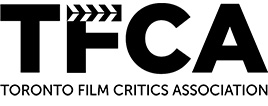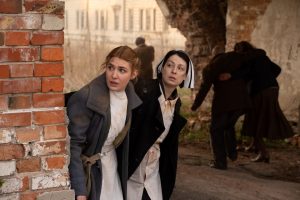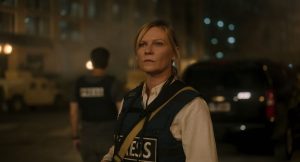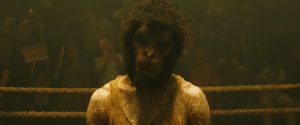Reviews include Irena’s Vow, The Beast, and Before I Change My Mind.
An Interview With: Sofia Bohdanowicz
March 23, 2017
A young filmmaker with an old soul.
The “emerging Canadian director” award bestowed on Sofia Bohdanowicz last October at the Vancouver International Film Festival was tied to the premiere of her new feature Never Eat Alone, a beautifully miniaturized character study of an elderly woman (played by the filmmaker’s grandmother) contemplating the space between her younger self and her life in the present tense.
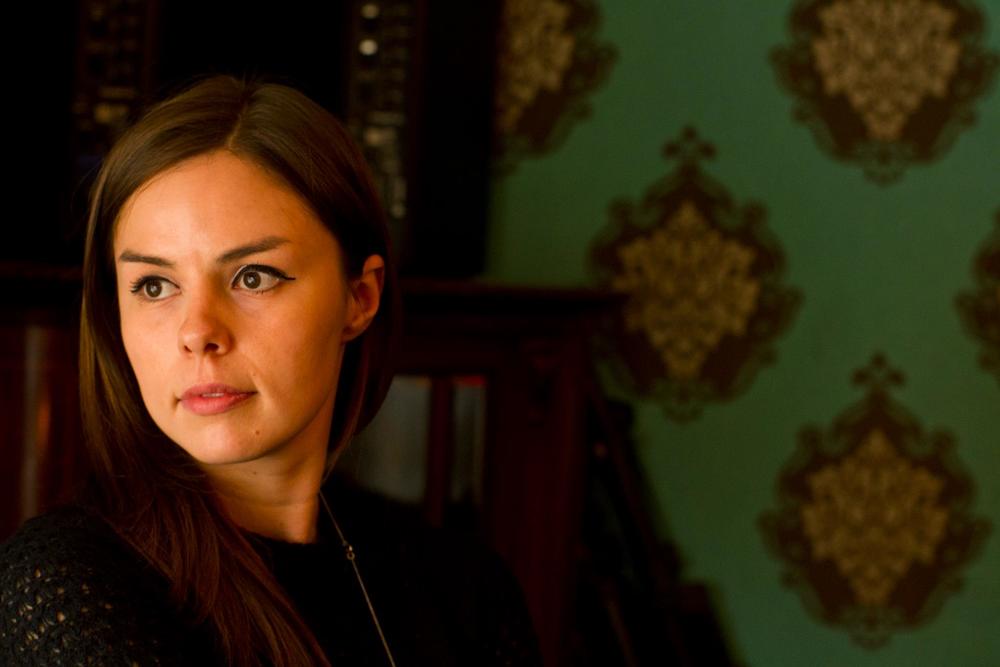
But Bohdanowicz has been on the radar of cinephiles in Canada and the United States for several years now: in 2015, she was invited to the Museum of the Moving Image in New York City to show a trilogy of short films that collectively work to collapse the distance between documentary, experimental, and essay-film formats. It was also announced this week that her new documentary, Maison du bonheur, has been selected for Hot Docs – her highest-profile festival premiere to date. So the timing couldn’t be better for TIFF Bell Lightbox ‘s upcoming programme showcasing four of the director’s key works to date.
Adam Nayman spoke to Bohdanowicz about her work, her process, and her influences.
Adam Nayman: Your working methods are very particular: the trilogy was shot in your grandmother’s house, and Never Eat Alone was from what I understand very much a micro-budget production. Does working outside traditional systems of funding and distribution give you a different sort of agility? Is there a way in which you can use it as an advantage?
Sofia Bohdanowicz: While it can be challenging to work with very little, I find that working outside of the system certainly gives me much more freedom. When I conceive of an idea, I usually develop it a little bit with my partner Calvin [Thomas] and come up with some kind of rough draft or plan of what I’d like to shoot. From there, I jump right into production and all of the interest and energy that I have from the get-go stays in my hands. If I develop something too much it can stagnate and a lot of my best decision making in production happens when I am shooting. Since my films are so personal, they are quite delicate in their early stages and forcing myself to articulate, in a competitive way, why my film should be funded can sometimes takes the love and enjoyment out of the process for me.
That’s not to say that I don’t apply for Arts Council grants, because I do! And from time to time I get a grant or two! Never Eat Alone actually had a microscopic budget of $7,500 from the Ontario Arts Council, and I had to be very creative and careful about how I spent and used that funding. I had to look at which aspects of the film were absolutely necessary and which ones had to hit the curb. There was no room for frivolity, and I think these constraints yielded interesting results. Never Eat Alone has quite a simple narrative and in order for it to work I needed to ensure that every piece of the plot fit just right and yes, it’s challenging to do that with no money but also very satisfying when it works.
Working outside of the funding system enables my work to be more authentic and honest. It’s very important to me to be able to protect and to continue to develop my voice, it took me a long time to find it! I’m not making these deeply personal films for funding bodies, production companies or studios, I am making them for myself and for audience members. I don’t want the pressure of feeling like I need to get anyone’s approval. It’s too much for me.
My style of filmmaking compliments my working out of the system as well, this is important to mention. I don’t work with big crews. I do all of the camera work myself (along with Calvin) as well as sound too. On Maison du bonheur, I did all of the foley myself! Having a strong hands-on approach with my filmmaking at every stage saves me a lot of money and it makes me autonomous. I don’t have to rely on anyone and I feel like there’s a lot of room to experiment and not feel self-conscious or apologetic about it.
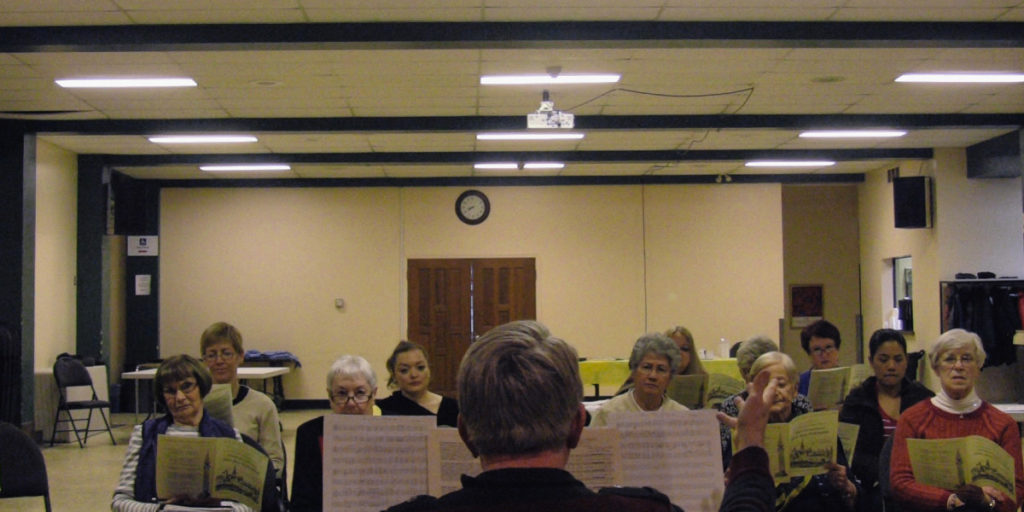
Can you talk about how the films in your trilogy came about? I know A Prayer was originally a stand-alone project and then the two follow-ups grew out of it naturally although unexpectedly…
So I had seen Akerman’s film Jeannne Dielman, 23 quai du Commerce, 1080 Bruxelles for the first time in TIFF’s Film Reference Library and I had never seen anything like it before. It was an anomaly for me to see a film with a strong female protagonist who was just simply living, and we were privy to that in such a real, authentic and unapologetic way. I had never seen a woman portrayed in this fashion before and I realized that this is something that I had been craving to see more on screen.
Up to this point in my film career I had only made one film based on my great grandmother’s poem Dundas Street [co-directed with Joanna Durkalec)] and I had been wanting to making more films based on her work. I started studying my great grandmother’s poem Modlitwa (A Prayer) and started dreaming up a simple idea that I could shoot with my paternal grandmother, Maria, as a test. So I set out to her place and spent the afternoon with her filming what she usually does, making food, eating it, gardening, napping, and doing laundry. I brought the footage home and showed my partner Calvin and said What do you think? Is this test footage interesting? Should I go back and shoot it for real? And he said This film is for real. You should edit it. And so I did and it worked.
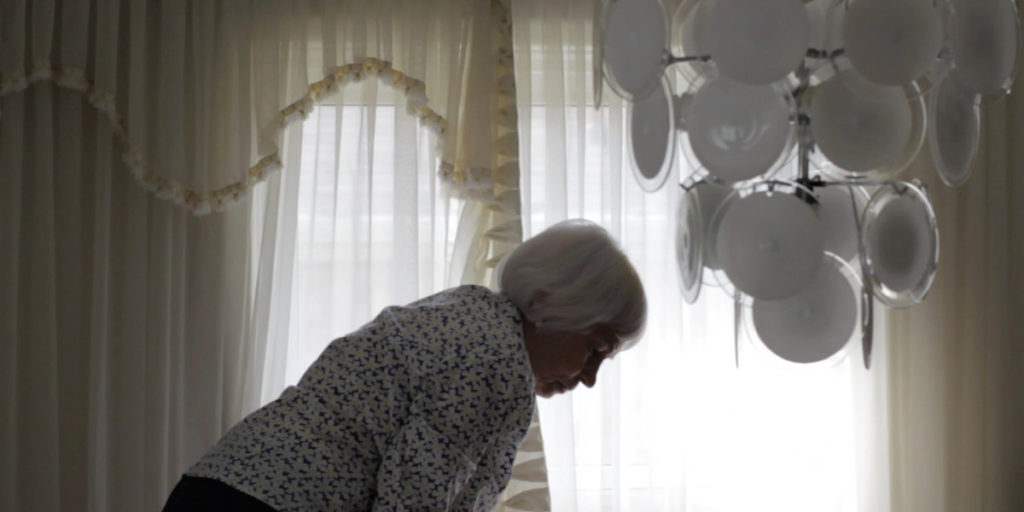
I was very lucky that I shot this film with my grandmother because several weeks later she was diagnosed with stage four cancer and swiftly passed away months later. I had accidentally shot our last normal afternoon together and turned it into a film which was I am so grateful to have.
After my grandmother’s passing, I started to realize that her home that I had grown up in and adored was going to be taken apart and dismantled. I panicked and started to get really upset. One day I got the idea that, perhaps before my family started to take the home apart, I would shoot every room as it was, so that I would have a visual archive of what her home looked and felt like. I ran the idea by my partner Calvin and he had the idea for us to shoot in the late afternoon to the evening and capture each room as the light started to disappear. I thought this was a brilliant idea so we set out to do this in her home. It was a really peaceful thing to do after her passing and it felt reassuring that I was making such a vivid and physical memory that would be preserved. I even recorded room tone in every room. I was very thorough.
She thought we were having a séance in there. She called me one day to say Sofia! I know what you’re doing and I don’t like it!
There was a record player in the basement and my family had already pilfered the collection. All that was left was a record titled Songs for Mother. I popped in on the record player (which I now own) and played it, the song was so enchanting that I started to record it. The record player is broken and there was this intense scratching noise (the needle was broken), which was intense but I found to be very interesting. When I started editing An Evening, my friend Joanna Durkalec (who directed Dundas Street with me) suggested that I start slowing the music down so as it gets darker and darker, the music transforms the atmosphere into something very macabre, and so a movie was born. I am fortunate to have such great friends and collaborators who listen to my ideas and help me develop them into something much better than I could have ever conceived on my own.
And how did you then get the idea to combine these two films into the third short, Another Prayer?
After shooting An Evening a few months later, I had the strange idea (I still don’t know where it came from), to re-project my film A Prayer onto empty surfaces of my grandmother’s home. The place had been emptied out and was going to be sold very soon and I ran the idea by Calvin. He never makes me feel strange, or self-conscious when I articulate new ideas to him, which is a big reason why I feel like I am able to execute a lot of my ideas. I never feel judged; just supported.
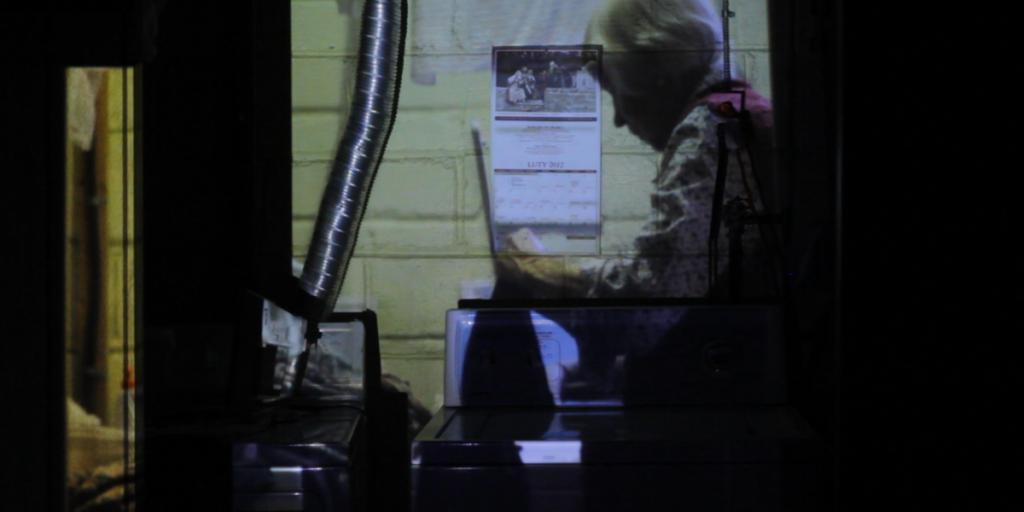
So I borrowed a projector from the office of my workplace and set out with Calvin and a friend of mine to shoot this experiment. I wasn’t sure if it would work, but it really did, and it was terrifying. Realizing that we had succeeded in recreating a simulated version of my grandmother’s presence felt wrong and eerie. Her neighbour could see us projecting things in her home and I have a feeling she thought we were having a séance in there. She called me one day to say Sofia! I know what you’re doing and I don’t like it! I tried to calmly explain the film’s concept to her and why we were doing it, I still don’t think she was very impressed with us but she still hung up some laundry for us that evening so that we would have something to project my Grandmother’s image onto it so she couldn’t have been that disapproving.
A Prayer strikes me as a movie that’s very much about presence, and An Evening deals with absence; by the time you get to Another Prayer, it’s like the film is suggesting that both can co-exist…
You’re exactly right. I think that sometimes when you have such a strong sentimental attachment to a space sometimes you can get lost in time and layers of history. I knew that my Grandmother’s home was a world that would one day cease to exist but this was my way of exploring different planes of what her presence could look and feel like after her passing.
The shooting style of Another Prayer is fascinating: how did you achieve that quality of superimposition?
We used an EPSON projector from my office job and a step-ladder, which was precarious! We didn’t have the proper equipment to execute what we wanted at first so much to our chagrin it took a long time to line things up just right. We shot the film over the course of two evenings. The first night that we shot the film, we were really spooked out, but also really pleased with ourselves when we wrapped. We looked at the footage and some of it really worked, and some of it didn’t. Our hearts sank when we realized we had to go back, but we did and really nailed the technique.
Not to get very supernatural with you but the computer that I work off of which I usually never have any problems with was really on the fritz when we were shooting and my camera was acting up as well. There was definitely a presence or a vibe that was around while we were working… or maybe it was our nerves! It felt really scary and intense at the time but I’m so very glad we did it.
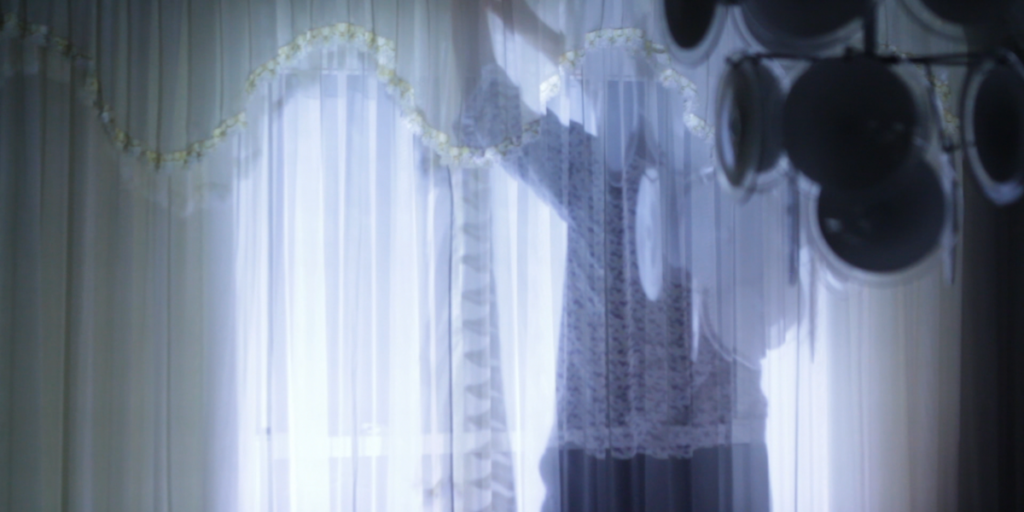
You seem very interested in older characters—not only your own grandmother in A Prayer, but also the grandmother figure in Never Eat Alone. It’s somewhat unusual for a younger director to make that sort of story a priority. Where does this fascination come from?
I grew up surrounded by a lot of elderly people. I was the firstborn in my family, I came into the world with both sets of grandparents and two great grandmothers. I was babysat and taken care of frequently by all of these grandparents who were great storytellers and often told me about their own histories, I loved it. Because my first experience with narrative was through my family I grew up with a desire and fascination to find a way to tell their stories through my own filmmaking because of how much I loved and admired them.
I feel like a lot of films do not represent elderly matriarchs in the way that I see them or have experienced them. Elderly women are usually stereotyped in film as tired, senile, angry, or confused. These representations are not how I see or have experienced these women who have played a hand in shaping my life. These matriarchs are not portrayed as full people that have needs, wants, desires and regrets. My hope is that my films can start a new conversation about how these women can be portrayed and lead a new example as to how histories can be celebrated.
How does Never Eat Alone stitch together fact and fiction? Did the project start with the discovery of the archival footage? And how did you decide to cast an actress (Deragh Campbell) in a role that’s really very personal to you. Is she playing a version of you in the film?
The project started with a small grant where I was going to film a simple project that has nothing to do with the final output of Never Eat Alone as it is now. I had this idea that I wanted to film different people eating different meals — like breakfast, lunch and dinner — so that if you were a person that was ever eating alone, you could pop on a DVD and eat a respective meal with a person and not feel so alone. It was an interactive project that I tried out that really didn’t work.
So I shifted my gaze to my maternal grandmother, Joan. When I started filming her eating and living in her home, doing day-to-day chores and activities, she started express a regret about a man that she had dated before meeting my grandfather and asked me to try and find him. At the same time, she had also told Calvin and me about this television episode that was a musical where she played a witch and I wanted to get my hands on it. These were two little gifts that fell on my lap during production that I just couldn’t resist incorporating into the film.
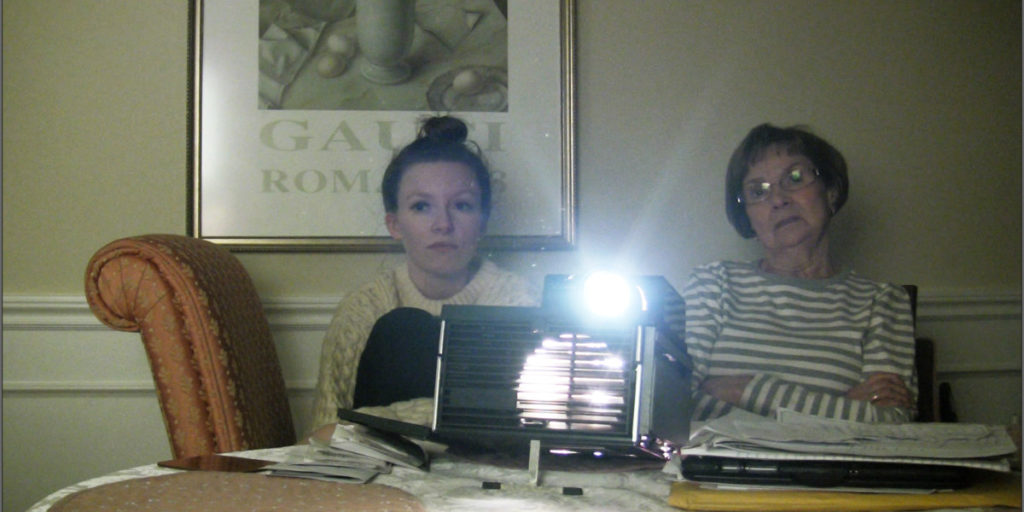
With all of the documentary footage I had shot with her as well as with Calvin’s grandfather, George, I started to develop a narrative line. I started to question if I could create a fictitious arc where Calvin’s grandfather was possibly the man in question (that my grandmother was searching for), and that the man in the footage that plays opposite to my grandmother is the man she was in love with. I tried to simply cut this footage together but it wasn’t working and I realized that I needed a vehicle to streamline all of these parts together. This is where Deragh Campbell came in. I decided to cast her as my grandmother’s granddaughter, and wrote all of these scenes where she was asked to find the man my grandmother was in love with and to search for this missing television episode, and it all kind of took off from there.
With a retrospective at TIFF, does it feel like this is a moment for you, in a way? Never Eat Alone was programmed at VIFF and is showing in other festivals, is there a sense of validation in having work produced via such a specific, non-industrial method break through like it has recently?
Absolutely. It has taken me a long time to find my voice, develop it and refine it. But also to have people listen to it. I think I was a little frustrated when I first started making work, because I had a hard time getting it programmed. I vented these misgivings to my friend and filmmaker, Lina Rodriguez, and she elegantly explained to me that it takes time to develop a body of work that creates an entire conversation. She told me that it takes time for people to hear your voice and to understand what exactly you’re trying to articulate within the context of other pieces of work. She encouraged me to keep going, to create more work and to continue the conversation I had initiated with Dundas Street. And so I did and here I am.
I am very touched that there is interest and attention for the work that I am making because it’s intensely personal. I was worried that when I started making this kind of work that it might be too subjective, or too vulnerable, but after screenings people come up to me to tell me that my films reminded them of their relationships with their own grandparents or can relate to my own feelings of grief that I share in my films and that is intensely satisfying for me and in a way is what matters most, is that emotional reaction and connection. The opportunity to share my work on bigger platforms where wider audiences will be able to reach them is very exciting for me. And yes, I definitely feel like it is breakthrough for independent filmmakers like me who who are rubbing their two cents together praying to be listened to. It sure is nice to feel like a legitimate filmmaker. When you’re making films on such a small level it can give you a lot of freedom creatively, but you can also get easily cast aside at film festivals. I think that sometimes the smallness of my productions can turn people off of my filmmaking before they even take a peek at it, but this is just speculation.
What can you say about your next film, which is slated to play at Hot Docs? How does it compare to your other work, and does it go anywhere significantly different?
My next film, Maison du bonheur, is another film that explores the life of an elderly astrologer living in Montmartre, in Paris, France. She’s a woman with a lot of deep-rooted habits and rituals. She’s been living in the same neighbourhood for over 50 years and has had the same hairdresser for 30. I shot the film on 16mm film on a Bolex and it almost has a 1:1 shooting ratio. I rolled 90 minutes of film and I used 62 minutes of it. Unlike the films that are based on family members, I had not met Juliane before I shot the film. I didn’t even speak with her on the phone, text or exchange and email. I just went. I had a good feeling about it all.
